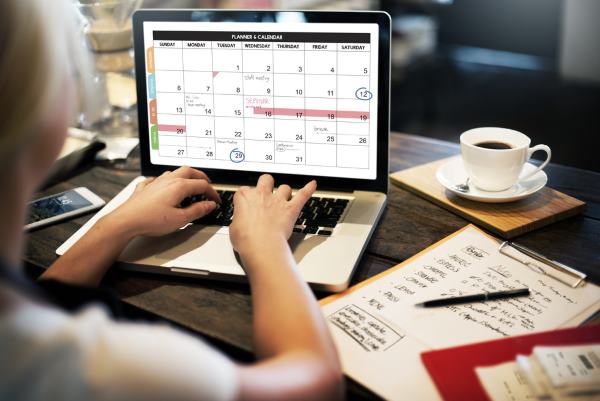
Time Blocking is a technique used to focus on a project. I’m guilty of not using this technique efficiently. It’s all too easy to keep your email browser open and immediately respond to the most recent inquiry or touch from a client. But all that back and forth leads to wasted time.
A colleague recently challenged me to keep track and time everything I do in the course of a week to see how my time is spent. By diligently working in this fashion – it has helped me to focus on the task at hand because in my mind I knew that I would need to record what I was doing. I actually put in an entry for nonproductive social media scrolling and personal calls I took during my workweek.
We all have our “To Do” lists and in a recent Tony Robbins podcast, I learned it’s not enough to have the 10 “To Do’s” to move from day to day but we need to pick the top 3 or 4 things that must be done that day and block the time on your calendar to do that given task. No phone calls, no interruptions, no email checks and no social media surfing – just focus at the task at hand.
ARE YOU THE MASTER OF YOUR DAILY SCHEDULE?
Most people let their calendar completely dictate their time. If it’s on the calendar, then it happens. You allow other people to take time from your calendar for calls to schedule appointments and to attend events. But, are you allowing YOURSELF to schedule work time on your calendar to complete projects that adhere to deadlines? By blocking off work time, you remain in control of your calendar and minimize the need to work late nights and weekends to complete projects on time. The end result is a better work life balance.
Large projects require focus and scheduling. It forces you to recognize your priorities and commit to action. This type of blocking helps to minimize procrastination. If you still can’t complete the action for the priority you set on your calendar, then perhaps it isn’t a priority and should be reevaluated.
Do you have Open Loops in your day? These are things that pop up and need to get done, but don’t have a concrete next step. They may float around in your head, pop up in the middle of the night, but they don’t have a priority. Get Things Done works by capturing and defining the next step somewhere that is not your head, ready to act on at a later moment. This is helpful, but doesn’t answer the final open loop about any task: when will I do this? Time blocking helps to prioritize and schedule those open loops with actionable next steps.
IMPROVE YOUR BOTTOM LINE
Time Blocking trains you to be better at estimating how long things take.
When you reach the end of a task before the block is up or reach the end of a block and still have stuff to do, you know you guessed wrong. Rearrange time later in the week to finish the task. Then, review why you estimated wrong. Was the project more complex, were you distracted? By fully understanding the time it takes to complete a task, you will accurately be able to bid future projects.
GIVE YOURSELF A BREAK
Don’t schedule time blocks back to back. Your brain and body need time to adjust to completing a task. I recently purchased a stand up desk and at times during the day shift from sitting to standing. It gives me a different focus.
Things happen throughout the day that can affect your schedule. Don’t sweat it, but be sure you’re the one who remains in control of your calendar and time.
About the author: Autumn Edmiston is the CEO and owner of the Edmiston Group. The Edmiston Group is a multifaceted Pittsburgh based marketing consulting firm providing senior level marketing management services to businesses and non-profit organizations on a short or long-term basis. Core areas of service are business development, marketing, strategic planning and public relations. The Edmiston Group has consistently delivered and implemented real-world, proven business marketing ideas and strategies for business.




 Now that you’ve started your business are you ready to take your small business to the next level? As a small business owner, you wear a lot of hats. Things such as scheduling employees, managing finances, creating marketing campaign – you name it! It’s hard work, but setting up processes can make a big difference. It allows others to step in and execute a particular task as you grow.
Now that you’ve started your business are you ready to take your small business to the next level? As a small business owner, you wear a lot of hats. Things such as scheduling employees, managing finances, creating marketing campaign – you name it! It’s hard work, but setting up processes can make a big difference. It allows others to step in and execute a particular task as you grow.
 There is a direct correlation between happy employees and happy customers. Employers are starting to recognize that keeping their employees happy and fulfilled at work means getting a little creative.
There is a direct correlation between happy employees and happy customers. Employers are starting to recognize that keeping their employees happy and fulfilled at work means getting a little creative.
 It’s time to scale your business but you’re not sure how. As a business owner, you may be working 6-7 days a week, wearing numerous hats, and are like a hamster running on a spinning wheel. The key here is you’re too busy working IN your business to take the time and work ON your business. The first quarter of 2019 is nearly over. Are you on target? Here are some tips for taking your business to another level.
It’s time to scale your business but you’re not sure how. As a business owner, you may be working 6-7 days a week, wearing numerous hats, and are like a hamster running on a spinning wheel. The key here is you’re too busy working IN your business to take the time and work ON your business. The first quarter of 2019 is nearly over. Are you on target? Here are some tips for taking your business to another level.


 Emotions drive most of our decisions, and that includes what we purchase. Think about it – when you attend a trade show the smell of freshly baked cookies or popcorn will draw you into an exhibitor’s booth.
Emotions drive most of our decisions, and that includes what we purchase. Think about it – when you attend a trade show the smell of freshly baked cookies or popcorn will draw you into an exhibitor’s booth.
 Are you helping your customers or selling? When you remember what your customers’ needs are and offer a solution to those needs, you’ll stand apart from the competition. By helping through offering insights and resources you take on a more humanistic approach in how you’re assisting your customers.
Are you helping your customers or selling? When you remember what your customers’ needs are and offer a solution to those needs, you’ll stand apart from the competition. By helping through offering insights and resources you take on a more humanistic approach in how you’re assisting your customers.
 Creating a marketing calendar (editorial calendar) is critical to your success and will be the cornerstone of the activities you will do to promote your business in 2019. It is simply the act of thinking through the year and putting a plan in place. You can make the calendar as simple or as complex as you like. Additionally, we recommend taking some time to create a social media calendar as well. The Edmiston Group creates a general calendar every year, but we also customize these calendars for particular businesses allowing them to easily execute.
Creating a marketing calendar (editorial calendar) is critical to your success and will be the cornerstone of the activities you will do to promote your business in 2019. It is simply the act of thinking through the year and putting a plan in place. You can make the calendar as simple or as complex as you like. Additionally, we recommend taking some time to create a social media calendar as well. The Edmiston Group creates a general calendar every year, but we also customize these calendars for particular businesses allowing them to easily execute. 
 For businesses that are serious about creating great content, having a blog is more important today than ever before. Blogs fit into your email marketing campaign and allow you to humanize your marketing with thoughts, advice, and insights. They help to establish you as an expert in your field.
For businesses that are serious about creating great content, having a blog is more important today than ever before. Blogs fit into your email marketing campaign and allow you to humanize your marketing with thoughts, advice, and insights. They help to establish you as an expert in your field.
 2018 is coming to a close. As a business owner or someone who works for a company, do you take the time and reflect back on the year to see if you hit the mark or where you fell short? If you don’t measure, you’re missing opportunities to either do more of what’s working or shift from actions that aren’t working. The one thing for certain is there will always be change.
2018 is coming to a close. As a business owner or someone who works for a company, do you take the time and reflect back on the year to see if you hit the mark or where you fell short? If you don’t measure, you’re missing opportunities to either do more of what’s working or shift from actions that aren’t working. The one thing for certain is there will always be change.
